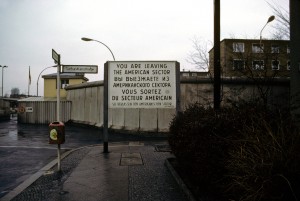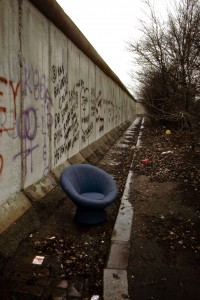I visited Berlin in March 1985, and at that time, you would have had a difficult time convincing me that the Berlin Wall and a divided Germany would end anytime soon. Taking the U-Bahn (subway or metro) beneath East Berlin, I encountered darkened platforms at abandoned stations patrolled by East German soldiers wielding machine guns. It seems that the Berlin transit ancestors had not laid out the system with easy partition of the city in mind. The one station still operated was Friedrichstraße, which had a full customs and immigration hall, and was the only crossing between East and West Berlin that could be used by both German nationals and foreigners. (Germans could not use Checkpoint Charlie.)
For my day trip to East Berlin, I memorized the information I needed to know from my Baedeker’s, since Western travel guides and maps were contraband, left my camera in my room (since cameras could be confiscated), and took the S-Bahn (regional/suburban train) over the Wall to Friedrichstraße. Although I had read that the Wall was actually several walls with a no-man zone between them, it was quite an eye-opener to see it.
Once I alighted the train at Friedrichstraße, I went downstairs into the immigration hall and waited in the set of lines for non-German nationals. The immigration officer started with me as he was finishing with the person ahead of me. He scrutinized my passport and me several times over, filled out a visa, and the only thing he said to either of us was, “Fünf Mark, bitte!” I would have believed that the five Marks was the most important part.
When I received my visa and my returned passport, he unlocked the door letting me into the customs hall, where I immediately had to buy 25 Marks in East German currency at the inflated rate of 1:1, even though you could buy 8 or more per D-Mark on the black market in West Berlin. Needless to say, I couldn’t have spent the 25 East German Marks if my life depended on it. None of the Soviet Bloc cities were known for their shopping. I suppose I could have stood in line and added my name to a 20-year waiting list for a refrigerator or something.
Most of the museums were in East Berlin, and it was nice to see them. It was interesting seeing all the Trabants on the street. Most were either white or pastel yellow. The pastel blue ones must have belonged to senior party officials, since they were rarer. Maps posted on the street pretended that West Berlin didn’t exist. Postcards took longer from East Berlin, too. As I recall, it took 6 to 8 weeks for a postcard to make it back to the States, whereas it was a week or so from West Germany.
German reunification was a good thing, but some people who grew up under the old system have a nostalgia for East Germany. Goodbye Lenin is an amusing film set during the fall of the Berlin Wall that came out at about the time that Ostalgie (the German word for nostalgia of East Germany) became a phenomenon. I recommend it.

